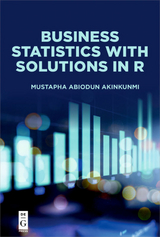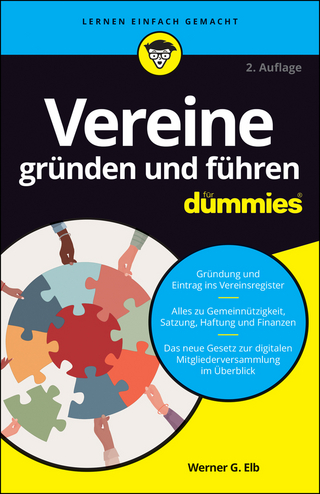Business Statistics with Solutions in R
De Gruyter (Verlag)
978-1-5474-1746-9 (ISBN)
Mustapha Abiodun Akinkunmi, associate professor of finance and chair of the accounting and finance department at the American University of Nigeria, Yola, Nigeria, is a financial economist and technology strategist with over 25 years of experience in estimation, planning, and forecasting using statistical and econometric methods, with particular expertise in risk, expected utility, discounting, binomial-tree valuation methods, financial econometrics models, Monte Carlo simulations, macroeconomics, and exchange rate modeling. Dr. Akinkunmi has performed extensive software development for quantitative analysis of capital markets, revenue and payment gateway, predictive analytics, data science, and credit risk management. He has worked as a business strategist with AT&T, Salomon Brothers, Goldman Sachs, Phibro Energy, First Boston (Credit Suisse First Boston), World Bank, and Central Bank of Nigeria. He has taught and researched at Manhattan College, Riverdale, NY; Fordham University, New York, NY; University of Lagos, Lagos, Nigeria; State University of New York-FIT, New York, NY; Montclair State University, Montclair, NJ; and American University, Yola, Nigeria. In 1990, he founded Technology Solutions Incorporated (TSI) in New York, which focused on data science and software application development for clients including major financial services institutions. Dr. Akinkunmi is the former Honorable Commissioner for Finance, Lagos State, Nigeria.
Chapter One: Introduction to Statistical Analysis
1.1 Scale of measurement
1.2 Data, data collection and presentation
1.3 Data grouping
1.4 Methods of visualizing data
1.5 Introduction to R software
Chapter Two: Descriptive Data
Chapter One: Introduction to Statistical Analysis
Scale of measurement
Data, data collection and presentation
Data grouping
Methods of visualizing data
Introduction to R software
Chapter Two: Descriptive Data
2.1. Measure of Central tendency
2.2. Measure of Dispersion
2.3. Shapes of the distribution—symmetric and asymmetric
2.4. Summary statistics of data using R
Chapter Three: Basic Probability Concepts
3.1. Experiment and sample space
3.2. Elementary events
3.3 Venn diagram and probability matrices for two sets probability problems.
3.4 Addition rule of probability
3.5 Independent events and dependent events.
3.6 Multiplication rule of probability
3.7 Conditional probabilities
Chapter Four: Discrete Probability Distributions
4.1. Expected value and variance of a discrete random variable
4.2. Binomial probability distribution
4.3. Expected value and variance of a binomial distribution
4.4. Solve problems involving binomial distribution using R
Chapter Five: Continuous Probability Distribution
5.1. Normal distribution and standardized normal distribution
5.2. Normal curve
5.3. Approximate normal to the binomial distribution
5.4. Use of the normal distribution in business problem solving using R
Chapter Six: Sampling and Sampling Distribution
6.1. Probability and non-probability sampling
6.2. Sampling techniques- simple random, systematic, stratified, and cluster samples
6.3. Sampling distribution of the mean
6.4. Central limit theorem and its significance
Chapter Seven: Confidence Intervals for Single Population Mean and Proportion
7.1. Point estimates and interval estimates
7.2. Confidence intervals for mean and proportion
7.3. Confidence interval for proportion
7.4 Factors that determine margin of error
Chapter Eight: Hypothesis Testing for Single Population Mean and Proportion
8.1. Null and alternative hypotheses
8.2 Type I and Type II Error
8.3. Acceptance and Rejection regions
8.4. Hypothesis testing procedure
Chapter Nine: Regression Analysis and Correlation
9.1. Construction of line fit plots
9.2. Types of regression analysis
9.2.1 Uses of regression analysis
9.2.2 Simple linear regression
9.2.3 Assumptions of simple linear regression
9.3. Multiple linear regression
9.3.1 Significance testing of each variable
9.3.2. Interpretation of regression coefficients and other output
9.4 Pearson correlation coefficient
9.4.1 Assumptions of correlation test
9.4.2 Types of correlation
9.4.3 Coefficient of determination
9.4.4 Test for the significance of correlation coefficient (r)
Chapter Ten: Poisson Distribution
10.1. Poisson distribution and its properties
10.2. Mean and variance of a Poisson distribution
10.3. Application of Poisson distribution
10.4. Poisson to approximate the Binomial
Chapter Eleven: Uniform Distribution
11.1. Uniform distribution and its properties
11.2. Mean and variance of a uniform distribution
11.3. Application of uniform distribution
Chapter Twelve: Statistical Process Control
12.1. Types of control chart
12.2 Uses of control chart
12.3 Procedure of control chart
12.4. Variable control charts
12.4.1. X-bar chart
12.4.1.1. Steps for constructing X-bar chart
12.4.2. Range chart
12.4.2.1. Steps for constructing R-chart
12.4.3. S-chart
12.4.4. NP chart
12.4.5. P chart
12.4.6. C chart
12.4.7. U chart
Chapter Thirteen: Time Series
13.1. Concept of Time series data
13.1.1 Uses and application of time series analysis
13.2 Univariate time series model
13.2.1 Generating a time-series object in R
13.2.2. Smoothing and seasonal decomposition
13.2.2.3. Exponential Forecasting Models
13.2.2.4. Holt and Holt-Winters exponential smoothing
13.2.2.5 The ets( ) function and automated forecasting
13.2.2.5. ARIMA forecasting models
13.3 Multivariate time series model
13.3.1. ARMA and ARIMA models
13.4 Recap
Chapter Fourteen: Multivariate Analysis
14.1. Properties of Multivariate Normal Distribution
14.2. Sampling from a Multivariate Normal Distribution and Maximum Likelihood Estimation
14.2.1. Multivariate Normal Distribution
14.2.2 Maximum Likelihood Estimation of Mean (μ) and Covariance matrix (Σ)
14.3 The Sampling Distribution X ̅ and
14.3.1 Wishart Distribution
14.3.2 Properties of the Wishart Distribution
14.3.3 Large Sample Properties of X ̅ and
14.4 Multivariate Normality
14.4.1 Q-Q Plot for Evaluating Multivariate Normality
14.4.1.1 Steps for Constructing Chi-squared plot
Chapter Fifteen: Inference About a Mean Vector
15.1 Test of Hypothesis [μ=μ_0]
15.2 Confidence Interval and Simultaneous Comparison of Component Means
15.2.1 Confidence Regions
15.2.2 Simultaneous Confidence Intervals
15.2.3 Bonferroni Method of Multiple Comparisons
15.2.3 Large Sample Inference about a Population Mean Vector
15.2.4 Multivariate Quality Control Charts
15.2.4.1 Univariate Case
15.2.4.1 Multivariate Case
Chapter Sixteen: Inference About a Mean Vector
16.1 Paired Comparisons
16.2 Repeated Measurement Comparisons
16.3 Comparisons of Mean Vectors from Two Populations
16.4 Several Multivariate Population Means Comparison.
16.4.1 Univariate Analysis of Variance (ANOVA)
16.4.1.1 Assumptions of ANOVA
16.4.2 Multivariate Analysis of Variance (MANOVA)
16.4.2.1 Assumptions of MANOVA
| Erscheinungsdatum | 21.10.2019 |
|---|---|
| Zusatzinfo | 30 Illustrations, black and white; 20 Tables, black and white |
| Verlagsort | Boston |
| Sprache | englisch |
| Maße | 155 x 230 mm |
| Gewicht | 470 g |
| Themenwelt | Sachbuch/Ratgeber ► Beruf / Finanzen / Recht / Wirtschaft ► Wirtschaft |
| Mathematik / Informatik ► Mathematik ► Finanz- / Wirtschaftsmathematik | |
| Mathematik / Informatik ► Mathematik ► Statistik | |
| Technik ► Architektur | |
| Wirtschaft ► Betriebswirtschaft / Management | |
| Wirtschaft ► Volkswirtschaftslehre ► Ökonometrie | |
| Schlagworte | AKINKUNMI • business • Confidence interval • Correlation • expected value • hypothesis testing • Probability • Probability, Sampling Distributions, Confidence in • Probability, Sampling Distributions, Confidence interval, Regression, Hypothesis testing, Time series, Expected value, Correlation • Regression • Sampling distributions • Statistics • Time Series |
| ISBN-10 | 1-5474-1746-3 / 1547417463 |
| ISBN-13 | 978-1-5474-1746-9 / 9781547417469 |
| Zustand | Neuware |
| Haben Sie eine Frage zum Produkt? |
aus dem Bereich




